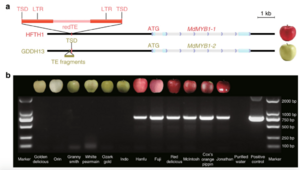Apple genome facts for kids
In 2010, scientists worked together to map out the entire genetic code of an apple. They used a 'Golden Delicious' apple for this important project.
They found the apple has about 57,000 genes. That's a lot! It's even more genes than humans have, which is around 25,000. Modern apples have 17 chromosomes (these are like tiny packages holding genes). Scientists discovered that these came from an older apple ancestor that had only 9 chromosomes. This ancestor's genes copied themselves many times, leading to more chromosomes.
This research also proved that a wild apple called Malus sieversii is the ancestor of the apples we eat today. This was something scientists had debated for a long time. In 2016, an even better map of the Golden Delicious apple's genes was published. This new understanding helps scientists find genes that make apples strong against diseases or dry weather. It also helps them find genes for other good traits. Knowing about these genes helps scientists breed better apples more effectively.
Contents
Unlocking the Apple's Secrets
Since the Golden Delicious apple's genetic map was published, many exciting discoveries have been made. For example, scientists learned that 60% of the apple's genetic code is made up of special bits called transposable elements. They also figured out what makes apples red.
What is a Genome?
A genome is like a complete instruction book for an organism. It contains all the genetic information needed for that organism to grow, develop, and function. This information is stored in genes, which are made of DNA. Genes are organized into structures called chromosomes. Think of chromosomes as chapters in the instruction book, and genes as individual instructions within those chapters.
Why Study Apple Genes?
Understanding the apple's genes helps us in many ways.
- Stronger Apples: Scientists can find genes that help apples fight off diseases or survive in dry conditions. This means we can grow healthier apples with less need for chemicals.
- Better Apples: By knowing which genes control traits like taste, crunchiness, or how long an apple stays fresh, scientists can breed new apple varieties that people will love even more.
- Protecting Nature: Learning about the wild ancestors of apples helps us understand how apples have changed over time and how to protect their natural diversity.
What Makes Apples Red?
Apple color is very important because most people prefer red apples. Scientists discovered that a specific gene called MdMYB1 is responsible for making apples red. This gene controls the production of red colors called anthocyanins in the apple's skin.
Scientists compared the genes of red Hanfu apples and yellow Golden Delicious apples. They found that even though the main parts of the MdMYB1 gene were the same, there were small differences in other areas around the gene.
One big difference was a special piece of DNA called `redTE`. This `redTE` was found in all red apples but not in any non-red apples. This suggests that `redTE` plays a key role in turning on the MdMYB1 gene, making the apple's skin red.


